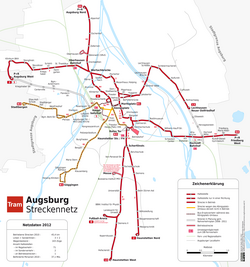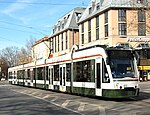
The Siemens Combino is a low-floor tram produced by Siemens Mobility. The first prototype was produced in 1996 at the Duewag works in Düsseldorf; the trams are now made in Krefeld-Uerdingen.

A low-floor tram is a tram that has no stairsteps between one or more entrances and part or all of the passenger cabin. The low-floor design improves the accessibility of the tram for the public, and also may provide larger windows and more airspace.
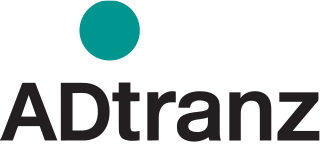
Adtranz was a multi-national rail transportation equipment manufacturer with facilities concentrated in Europe and the US. The company, legally known as ABB Daimler-Benz Transportation was created in 1996 as a joint venture between ABB and Daimler-Benz to combine their rail equipment manufacturing operations. In 1999, DaimlerChrysler bought ABB's shares and changed the company's official name to DaimlerChrysler Rail Systems. The company was acquired by Bombardier Inc. in 2001, which merged it into its Bombardier Transportation division, which became the largest rail equipment manufacturer in the world at the time, and was ultimately acquired by Alstom in 2021.
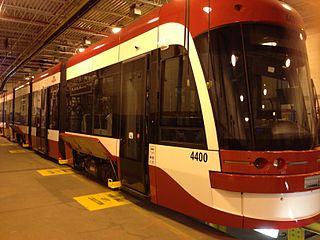
The Bombardier Flexity Outlook is a series of low-floored, articulated light-rail trams manufactured by Bombardier Transportation. Part of the larger Bombardier Flexity product line, Flexity Outlook vehicles are modular in design and commonly used throughout Europe.

The Bombardier Cobra is an articulated, low-floor tram operated by Verkehrsbetriebe Zürich (VBZ) of Zürich and manufactured by Bombardier Transportation. The Cobra was originally designed by a consortium consisting of the ABB Group, Pininfarina, the Schindler Group and Schweizerische Industrie Gesellschaft (SIG), who built several Cobra prototypes; however, all production Cobras have been manufactured by Bombardier.

The ADtranz low floor tram was introduced in the 1990s as the world's first tram with a completely low floor design. This tram was developed by MAN for the Bremen urban transport system. The prototype, tram number 3801, was first publicly introduced on 9 February 1990. From 1991 to 1993, it was being tested in many European cities. Ten German cities have purchased this type. Adtranz took over the rail division of MAN in 1990.

Augsburg Hauptbahnhof is the main railway station in the Bavarian city of Augsburg, situated in southern Germany. It is classified by Deutsche Bahn as a category 2 station and has 12 platform tracks.

The Bielefeld Stadtbahn is a metre gauge light rail network in the German city of Bielefeld, North Rhine-Westphalia, Germany. The system does include some segments built to rapid transit standards. It is operated by moBiel, a subsidiary of the Bielefeld municipal authority (Stadtwerke), and integrated in the Westfalentarif transport association. It served 32.77 million passengers in 2012.
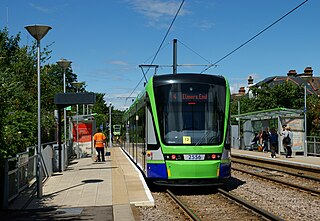
The Stadler Variobahn is a German-designed model of articulated low-floor tram and light rail vehicle. Since its introduction in 1993, the Variobahn has been manufactured variously by ABB, Adtranz, Bombardier Transportation, and since 2001 by Stadler Rail. As of 2009, 254 trams have been ordered, with an additional 110 on option. A unit costs about €2.5 million.

The Munich tramway is the tramway network for the city of Munich in Germany. Today it is operated by the municipally owned Münchner Verkehrsgesellschaft and is known officially and colloquially as the Tram. Previous operators have included Société Anonyme des Tramways de Munich, the Münchner Trambahn-Aktiengesellschaft, the Städtische Straßenbahnen and the Straßenbahn München.

The Potsdam tramway network is a network of tramways forming part of the public transport system in Potsdam, the capital city of the federal state of Brandenburg, Germany.

The Kassel tramway network is a 93.3-kilometer (58.0 mi) network of tramways, forming part of the public transport system in Kassel, a city in the north of the federal state of Hesse, Germany. As of 2014, the Kassel tram network is made up of seven regular tramlines.

The Mainz tramway network is a network of tramways forming part of the public transport system in Mainz, the capital city of the federal state of Rhineland-Palatinate, Germany.
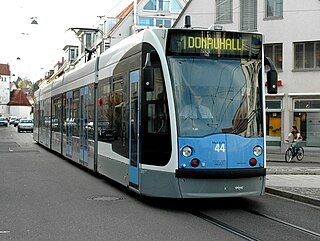
The Ulm tramway network is a network of tramways forming part of the public transport system in Ulm, a city in the federal state of Baden-Württemberg, Germany.

The Nordhausen tramway network is a network of tramways forming part of the public transport system in Nordhausen, a city in the federal state of Thuringia, Germany.

The Jena tramway network is a network of tramways forming part of the public transport system in Jena, a city in the federal state of Thuringia, Germany.

The Darmstadt tram network is a light rail system and the backbone of public transport within Darmstadt, a city in the federal state of Hesse, Germany. As of 2014, nine lines on four main routes serve 162 stops, including 92 low-floor stops. The system is operated by HEAG mobilo, and is an integral part of the Rhein-Main-Verkehrsverbund (RMV), the public transit authority of the Rhein-Main-Area.

The Frankfurt (Oder) tramway network is a network of tramways forming part of the public transport system in Frankfurt (Oder), a town in the federal state of Brandenburg, Germany, on the Oder River, at the German-Polish border.

The Essen tramway network is a 52.4-kilometer (32.6 mi) network of tramways forming part of the public transport system in Essen, a city in the federal state of North Rhine-Westphalia, Germany. Parts of the system also serve the neighbouring city of Gelsenkirchen.

The Erfurt Stadtbahn is a light rail network that is the basic public transit system of Erfurt, the capital of Thuringia in Germany. It represents the evolution of the city's original tramway which, outside of the city center, travels on track in its own right-of-way. The meter gauge network is made up of six lines, and has a total route length of 45.2 kilometers (28.1 mi), making it one of Germany's more moderate-sized Stadtbahn networks. The network is run by Stadtwerken Erfurter Verkehrsbetriebe AG, and is integrated in the Verkehrsverbund Mittelthüringen (VMT). The Stadtbahn carried 41.933 million passengers in 2012, which corresponds to about 114,885 passengers per day.


